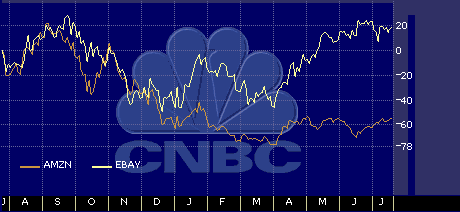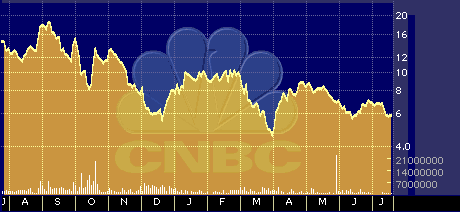
One Step Ahead: More Health-Care IPOs?
One Step Ahead: More Health-Care IPOs?
by Hal Plotkin
Silicon Valley Correspondent
Need surplus medical equipment or an update on prostate surgical procedures? Two companies are trying to extend the concepts behind eBay Inc. {EBAY} and Amazon.com Inc. {AMZN} to the lucrative business of catering to health-care companies.
Analysts say the pending Neoforma.com and Healthstream Inc. initial public offerings could help jump-start an ailing sector that hasn’t really capitalized on the Web. And, to borrow a catchphrase from priceline.com Inc. {PRCL}: It could be really big.

52-week comparison chart: AMZN vs. EBAY
In 1997, health-related spending in the United States alone topped $1 trillion — a number that can only grow as baby boomers age during the next decade.
“Neoforma and Healthstream are very different companies,” says Eric Brown, chief health-care analyst at Forrester Research based in Cambridge, Mass. “But what they’re doing gets the Internet juices flowing.”
Santa Clara, Calif.-based Neoforma, which filed to go public on Oct. 15, is trying to create a kind of eBay for the health-care industry. The firm envisions itself as a full-service provider of medical equipment and facility-design services.
One of the key components of Neoforma’s strategy involves the hosting of auctions where surplus high-priced medical equipment and supplies can be sold or exchanged among health-care professionals. “It’s an interesting and exciting concept,” Brown says.
Last May, the company inked a marketing arrangement with Santa Clara, Calif.-based Healtheon Corp. {HLTH} to jointly promote Neoforma’s method of selling new and used medical equipment.
Healthstream, based in Nashville, Tenn., filed to go public on Oct. 13. The company is targeting a different part of the health-care business-to-business infrastructure, addressing the need for continuing medical education for health-care providers.
Analysts say CME could be one of the early success stories when it comes to the health-care industry’s use of the Internet, due largely to the fact that most physicians and other skilled medical professionals own computers and are comfortable using the latest technologies.
“The ability to do CME over the Internet is a natural progression for CME,” says Darren Marhula, an analyst at U.S. Bancorp Piper Jaffray, based in Minneapolis.

HLTH 9-month chart
Both companies face considerable competition. But if their IPOs are well-received, the positive attention could do a lot to help spur additional deployment of Internet solutions in the health-care sector.
It’s an industry that has, so far, largely resisted the attempts of Internet companies that are trying to streamline notoriously bloated and inefficient medical procurement, billing, and record-keeping procedures.
“The system has $11 billion worth of waste in the supply chain each year,” Marhula says.
Eliminating that waste, however, is no walk in the park.
Analysts say legacy systems, traditional industry practices, the dominance of a handful of major medical-equipment distributors, and preexisting hospital and medical center group purchasing arrangements are holding the health-care sector back from the type of Internet-fostered “disintermediation” that is rapidly taking hold in many other parts of the economy.
“The industry’s electronic data interchange infrastructure is hanging like a millstone around the necks of many health-care institutions,” Brown says.
Peter Boland, a health-care industry analyst and founder of Boland Healthcare, based in Berkeley, Calif., agrees. “Some of the early Internet health care b-to-b companies clearly underestimated the difficulties involved in changing traditional business practices,” he says. “It’s a lot more complicated than selling books online.” Boland notes, for example, that Healtheon has encountered difficulties delivering some of its promised products and services to major clients on time.
“I think the b-to-b side is going to be very, very tricky,” adds Dr. Wally Buch, a physician and general partner at Atherton Ventures, an investment group based in Menlo Park, Calif. “It will be very hard to disintermediate the hospitals. They’re notoriously conservative and reluctant to get rid of the group purchasing organizations. It’s going to be quite a task.”
Healthstream and Neoforma may, however, have found a way out of that box.
Rather than try a wholesale approach to changing the health-care system, the companies are taking incremental steps to improve discrete parts of the medical-care delivery infrastructure.
“The health-care industry is a late bloomer when it comes to the Internet,” Brown says. “But there can be early successes even in a late bloomer.”
Brown says he likes the fact that health-care equipment buyers can use Neoforma’s services with a desktop browser, rather than having to install an entirely new procurement management system. And Healthstream, he says, “is in a very good early market. The docs at home are affluent and well-PC’d.”
Richard Lee, an analyst at Wit Capital, won’t comment on the prospects for the IPOs of either firm. But he says investors should realize that, in many cases, health-care buyers are restrained from buying equipment or services over the Web at the most-competitive prices.
“Trying to disintermediate the distributors is a pipe dream,” Lee says. “There’s been a lot of push-back on the b-to-b side. Companies are not making a huge amount of inroads.”
Lee is not, however, without hope for such firms.
“The best approach is to try to get the existing distributors [of health-care products and services] on their sites as a way to drive incremental sales,” Lee says. He says that’s already starting to happen, citing privately held Medibuy Inc., based in San Diego, as an early champion of what he thinks will be a winning business model.
Marhula counters that it’s only a matter of time before the Internet’s inevitable impact on the health-care industry becomes apparent.
“There’s no question the health-care industry is unique,” Marhula says. “It’s too early to tell which models will work. But the b-to-b health-care space is still extremely strong with a lot of opportunity.”
At least one b-to-b health-care company, Lexington, Mass.-based eMed Technologies Corp., which specializes in the electronic transmission of medical images and related information, has decided to wait a while longer before trying to cash in on that opportunity.
Earlier this month, the company announced the postponement of its planned IPO, citing the familiar “market conditions.” A company representative says eMed will likely refile for an IPO sometime during the first half of next year.
Neforma posted a loss of $8.1 million on revenue of $7,000 for the six months ended June 30, while Healthstream reported a loss of $1.4 million on sales of $1.1 million during the same period.


